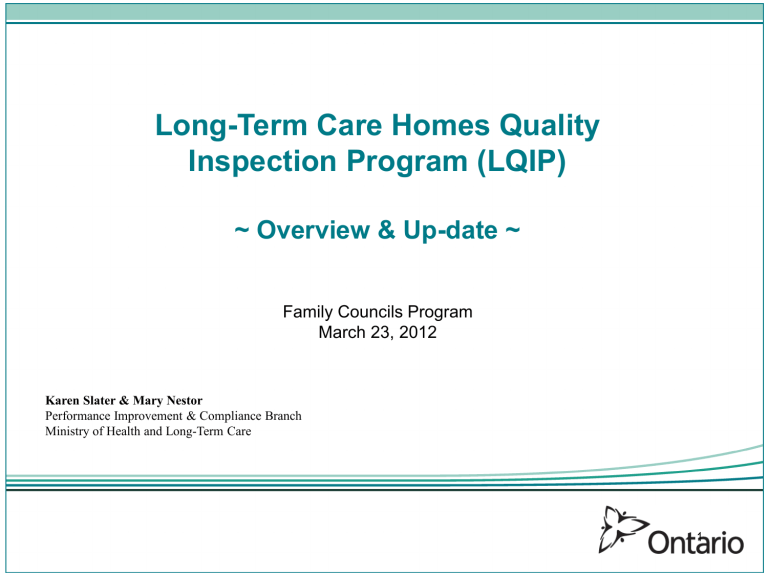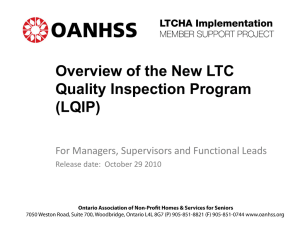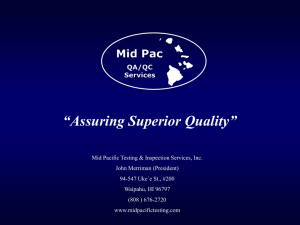LQIP - Family Councils` Program

Long-Term Care Homes Quality
Inspection Program (LQIP)
~ Overview & Up-date ~
Family Councils Program
March 23, 2012
Karen Slater & Mary Nestor
Performance Improvement & Compliance Branch
Ministry of Health and Long-Term Care
1
Agenda
1.
Compliance Transformation to Compliance Transformed – overview
2.
LQIP Implementation Status
3.
Inspection Data
4.
Family Councils ~ Provisions under LTCHA
Appendices
A.
Additional Questions
B.
Overview ~ RQI (Resident Quality Inspection)
C.
Inspection Protocols (IPs) – significance & use
Performance Improvement and Compliance Branch
Health System Accountability and Performance Division
2
Ontario LTC Home Quality Agenda
2010
•
LTCHA in force July 1
•
Introduction of the new inspection process
630+ Long-Term
Care Homes
(77,228 beds)
2009
•
First LTC Public Report Card
•
Residents First Program
2008
•
Key Risk Indicator Development
•
Beginning of Compliance
Transformation
2007 Development of the LTCHA
Performance Improvement and Compliance Branch
Health System Accountability and Performance Division
2005 Beginning of RAI-MDS 2.0
Implementation
3
Performance Improvement & Compliance Branch (PICB)
LQIP function
• Branch established in 2007
• LQIP introduced in July 2010
• 81 inspectors: Nursing, Dietary,
Environmental Health
• 5 Service Area Offices: Toronto,
Hamilton, Ottawa, London, Sudbury
• 2 Senior Managers
• Types of inspections: comprehensive (RQI), complaint, critical incident, follow-up and others
Performance Improvement and Compliance Branch
Health System Accountability and Performance Division
4
The New Inspection System ~ LQIP
The Long-Term Care Homes Act, 2007 (the Act) is the foundation of the government’s commitment to reforming the accountability of the long-term care home system. The Act and its regulations came into force on July 1, 2010.
The new comprehensive inspection program, Long-Term Care Homes Quality
Inspection Program (LQIP), focuses on the residents’ quality of care and quality of life.
The cornerstone of LQIP is the comprehensive inspection – Resident Quality
Inspection (RQI)
Resident-centred process:
Residents are surveyed, documentation is reviewed
Residents and families feel heard and valued
The outcomes of these activities determine where the inspectors need to conduct an in-depth inspection in RQI Stage 2 to determine compliance with the Act and regulations
5
The New Inspection System ~ LQIP (cont’d)
Extensive research by clinical experts to identify the quality of life,
quality of care and screening indicators required in the inspection process to identify potential presence of non-compliance
Resident responses and care outcomes guide the inspection process.
Evidence-based approach means results are much less subject to interpretation
Improved objectivity and consistency of quality of care/quality of life problem identification through a structured information gathering process
Greater automation facilitates better organization of inspection findings and enhanced documentation
Also targets inspection resources on homes with the largest number of quality concerns for improved risk management and resource deployment
Performance Improvement and Compliance Branch
Health System Accountability and Performance Division
6
LQIP
Implementation Status
Performance Improvement and Compliance Branch
Health System Accountability and Performance Division
7
Implemented
Resident Quality Inspections (RQI)
commenced February 2011
represents a comprehensive inspection of a LTCH
foundation of LQIP
strategy & “roll-out” plan being developed to address completion of RQIs on a go-forward
Complaint Inspections
Critical Incident Inspections
Follow-up Inspections
all Orders require a follow-up inspection
Performance Improvement and Compliance Branch
Health System Accountability and Performance Division
8
Implemented (cont’d)
SAO-Initiated Inspections
r/t transitional requirement for inspections in all LTCHs by
Dec.31/2011
aligned with RQI framework
short inspection (usually one day)
risk-based approach
features: tour of LTCH, interview with Residents’ Council, dining observation, (IPs: Residents’ Council Interview, Quality
Improvement, Dining Observation)
Performance Improvement and Compliance Branch
Health System Accountability and Performance Division
9
Implemented (cont’d)
Inspector training in RQI
completed April / May 2011
all inspectors trained and “adhered” (certified) in RQI
Satisfaction Surveys
post-RQI
residents, families, LTCHs
Inspection Protocols – 2 nd version released in April 2011
posted on ltchomes.net
French translation completed
Inspectors’ Handbook
policies and procedures, reference and support manual for inspectors
ensure inspection process integrity and standardization
Performance Improvement and Compliance Branch
Health System Accountability and Performance Division
10
Implemented (cont’d)
Inspection data reporting
quantity & quality of available reports is increasing
Continuing education and support for inspectors
Extensive I.T. systems development & implementation
supports inspection process
critical to RQIs (abaqis and IQS)
instrumental in data collection and reporting
Publishing of Inspection Reports [LTCHA s. 173]
Via MOHLTC public website
narrative/ explanatory portion up-dated & written in “plain language”
all Reports up to June 30 th posted in February with completion anticipated by
May 31st remainder on a schedule after that
anticipated that there will be in excess of 3,000 reports and Orders a year published through this website (approximately 250 per month)
goal is to publish the Report within 2 of serving the Report on the Licensee
Performance Improvement and Compliance Branch
Health System Accountability and Performance Division
11
Coming Soon
Centralized Intake, Assessment and Triage (CIAT)
design and development underway
will provide consistency and standardization in this critical function
CQI Activities:
CQI Framework – built on 3 pillars:
1.
2.
Program performance (internal)
LTCHs inspection results / performance (external)
3.
Resident experience
QCLI Threshold Review – initial review
RQI Reviews – designing “embedded” review process to ensure ongoing integrity of inspection methodology
Performance Improvement and Compliance Branch
Health System Accountability and Performance Division
12
Inspection Data
Performance Improvement and Compliance Branch
Health System Accountability and Performance Division
13
Provincial Inspections from
July 1, 2010 – March 10, 2012
Inspection Type
Complaint Inspection
Critical Incident Inspections
Follow-up
Other*
RQI
TOTAL
#
1885
1383
405
267
51
3991
% of Total Inspections
47%
35%
10%
6%
1%
* Other inspections include: SAO-Initiated inspections, Post-occupancy
Special Inspection, etc
Performance Improvement and Compliance Branch
Health System Accountability and Performance Division
14
Provincial Findings from
July 1, 2010 – October 15, 2011
Non-compliance
Written Notification (with no other action)
Voluntary Plan of Correction
(VPC)
2515
1880
#
Compliance Orders (CO) 477
Referral to the Director (DR) 3
Total * ~ 4875
% of non-compliances
52%
39%
10%
<1%
*Total does not include Written Notifications associated with a VPC, CO or
DR.
Performance Improvement and Compliance Branch
Health System Accountability and Performance Division
15
LTC Action Line Intake
January - October 2010 January - October 2011
LTC Intake Call
Reports sent to
Service Area Offices
2086
•
From 2010 – 2011:
15% increase in the # of reports sent to SAO’s
2399
Performance Improvement and Compliance Branch
Health System Accountability and Performance Division
16
6 Most Frequent Areas of Non-Compliance
July 1, 2010 – October 15, 2011
1.
Plan of Care
2.
Policies to be followed
3.
Duty to Protect
[NEW]
4.
Residents’ Bill of Rights
5.
Transferring and positioning techniques
6.
Accommodation services – cleanliness and repair
Performance Improvement and Compliance Branch
Health System Accountability and Performance Division
17
Top 10 Most Frequently Cited Non-Compliance
July 1, 2010 – October 15, 2011
Non-compliance
LTCHA s.6 (7)
LTCHA s.6 (1)(c)
LTCHA s. 6 (1)
O. Reg. 79/10 8 (1)(b)
Description # of Homes
Cited
264 Plan of Care ~ The licensee shall ensure that the care set out in the plan of care is provided to the resident as specified in the plan
Plan of Care ~ clear directions to staff and others who provide care
Plan of Care ~ sets the planned care, goals and provides clear direction
Policies ~ comply with own policies
217
132
128
LTCHA s. 19 (1) Duty to protect ~ every licensee of a long-term care home shall protect residents from abuse by anyone and shall ensure that residents are not neglected by the licensee or staff
97
LTCHA s. 6 (10)(b)
O. Reg. 79/10 s. 8 (1)(a)
Plan of Care ~ reassessment & revision when resident’s care needs change
Policies ~ in compliance with the LTCHA
LTCHA s. 3 (1)
O. Reg. 79/10 s. 36
Residents’ Bill of Rights
Transferring and positioning techniques
LTCHA s. 15 (2) (c) Accommodation services ~ furnishings & equipment maintained in safe condition & good state of repair
Performance Improvement and Compliance Branch
Health System Accountability and Performance Division
97
90
85
74
54
18
Family Councils
Provisions under LTCHA s. 59 to 61 ~ Family Council s. 62 to 68 ~ General
Performance Improvement and Compliance Branch
Health System Accountability and Performance Division
19
LTCHA, Part IV (Councils)
Sections 59 to 61 re Family Council
Section 59 – Family Council
s. 59(1) – Family Council Every LTCH may have a Family Council
s. 59(2) – Request for FC
s. 59(3) – Licensee to assist
If no FC, a family member of a resident or a person of importance to a resident may request the establishment
Licensee shall assist in establishing a FC within 30 days of receiving request
s. 59(4) – Notification of
Director
When FC established, licensee to notify Director within
30 days of establishment
s. 59(5) – Right to be a member Family member of a resident or a person of importance to a resident may be a member
s. 59(6) – Who may not be a member
List of persons who may not be members: ex. licensee or management of LTCH, officer/director of licensee, LTCH
Administrator or staff
s. 59(7) – Licensee obligations if no FC
Performance Improvement and Compliance Branch
Health System Accountability and Performance Division
If no FC, licensee shall: (a) advise of right to establish; and
(b) convene semi-annual mtgs to advise of right to establish
20
LTCHA, Part IV (Councils)
Sections 59 to 61 re Family Council (cont’d)
s. 60(1) – Powers of
Family Council
Any or all of the following:
Section 60 – Powers of Family Council
1. Provide assistance, information & advise to residents, family members of residents & persons of importance to residents incl. newly admitted residents
2. Advise re rights & obligations under the LTCHA
3. Advise re rights & obligations of the licensee under the LTCHA or agreement
4. Attempt to resolve disputes between licensee & residents
5. Sponsor and plan activities for residents
6. Collaborate w/ community groups & volunteers re activities for residents
Performance Improvement and Compliance Branch
Health System Accountability and Performance Division
21
LTCHA, Part IV (Councils)
Sections 59 to 61 re Family Council (cont’d)
s. 60(2) – Duty to respond
Section 60 – Powers of Family Council (cont’d)
(Cont’d)
s. 60(1) – Powers of
Family Council
Any or all of the following:
7. Review: i.
inspection reports & summaries received under s. 149 [re required inspections]; ii.
detailed allocation, by the licensee, of funding under LTCHA & amounts paid by residents iii.
Financial statements re the home filed w/ the Director under the regulations; and iv.
the operation of the home
8. Advise the licensee of any concerns/recommendations from
FC re operations of the home
9. Report to the Director any concerns/recommendations that, in opinion of FC should be brought to the Director’s attention
10. Exercise any other powers provided for in regulations
If FC has advised the licensee of concerns/recommendations, the licensee shall respond to FC in writing, within 10 days of receiving the advice
Performance Improvement and Compliance Branch
Health System Accountability and Performance Division
22
LTCHA, Part IV (Councils)
Sections 59 to 61 re Family Council (cont’d)
s. 61(2) – Duties
Section 61 – Family Council assistant
s. 61(1) – Family Council assistant
If FC requests, the licensee shall appoint a Family Council assistant who is acceptable to FC and who will assist the
FC
FC assistant will take instructions from FC, ensure confidentiality where requested and report to the FC
Performance Improvement and Compliance Branch
Health System Accountability and Performance Division
23
LTCHA, Part IV (Councils)
Sections 62 to 68 re General provisions re Councils
Section 62 to 68 – General
s. 62 – Licensee to co-operate with & assist Councils
Licensee to co-operate w/ RC & FC and their assistants, and provide such financial & other information & assistance required by regulation
s. 63 – Licensee duty to meet w/ Council
If invited by RC/FC, licensee shall meet, or if licensee is a corporation, representatives of the licensee shall meet
s. 64 – Attendance @ meetings Licensee shall attend meetings only if invited and ensure that staff, including Administrator, and other persons involved in the management/operation of the home, only attend a meeting if invited
Performance Improvement and Compliance Branch
Health System Accountability and Performance Division
24
LTCHA, Part IV (Councils)
Sections 62 to 68 re General provisions re Councils (cont’d)
Section 62 to 68 – General (cont’d)
s. 65 – No interference by licensee
A licensee of a LTCH:
(a) shall not interfere w/ meetings or operation of RC/FC
(b) shall not prevent a member if the RC/FC from
entering the home to attend a meeting of the Council or to perform any function as a member of the Council and shall not otherwise hinder, obstruct or interfere with such a member carrying out those functions
(c) shall not prevent a RC/FC assistant from entering the home to carry out duties or otherwise hinder, obstruct or interfere with the assistant carrying out duties
(d) shall ensure that no staff member, including
Administrator, and other persons involved in the management/operation of the home does anything the licensee is forbidden to do
Performance Improvement and Compliance Branch
Health System Accountability and Performance Division
25
LTCHA, Part IV (Councils)
Sections 62 to 68 re General provisions re Councils (cont’d)
Section 62 to 68 – General (cont’d)
s. 66 – Immunity – Council members, assistants
s. 67 – Duty of Licensee to consult Councils
No action or proceeding shall be commenced against a member of RC/FC or their assistants for anything done or omitted to be done in good faith in their capacity as a member or assistant
Licensee has duty to consult regularly w/ RC/FC (if any), and in any case, shall consult w/ them every 3 months
s. 68 – Regulations Regulation-making provisions – Power of Lieutenant
Governor in Council to make regulations
Performance Improvement and Compliance Branch
Health System Accountability and Performance Division
26
APPENDIX A
Additional Questions
Performance Improvement and Compliance Branch
Health System Accountability and Performance Division
27
Additional Questions
1. If a Family Council makes a request from a home and does not get an answer – what recourse does the Family
Council have?
2. Is the MOHLTC aware of the frustration of family members when there hasn’t been an inspection?
Performance Improvement and Compliance Branch
Health System Accountability and Performance Division
28
APPENDIX B
Overview
Resident Quality Inspection (RQI)
Performance Improvement and Compliance Branch
Health System Accountability and Performance Division
29
RQI: How it works
Two-stage inspection process
Stage 1:
A preliminary inspection is conducted using interviews, records and observations of 40 residents (randomly selected) to target Stage 2 in-depth inspections. No non-compliances are determined at this stage.
Stage 2:
In-depth inspection in care areas targeted based on Stage 1 to determine compliance with the Long-Term Care Homes Act,
2007 and Regulations.
30
Made-in-Ontario Solution – Resident Quality Inspection (RQI)
(Based on USA QIS Methodology)
Stage 1:
Resident, family and staff interviews
Residents’ Council and Family Council interviews
Team inspections
Standard sample of residents randomly selected from RAI-MDS data feed
Mandatory audits of core requirements
Data is categorized and compared against pre-set thresholds
Aligned to LTCHA with adaptations and Ontario thresholds validated through field tests
If thresholds are exceeded, compliance with minimum standards in resident care areas and practices may be at risk, triggering a further inspection protocol for Stage 2
System includes extensive training and reliability checks for inspectors
Performance Improvement and Compliance Branch
Health System Accountability and Performance Division
31
Quality of Care and Life Indicators (QCLIs)
Where does information come from?
MDS - includes Risk
Indicators
40%
Resident Interview
13%
Resident
Observation
21%
Staff Interview
6% Record Review
10%
Family/Designate
Interview
12%
Resident Interview (17)
Family/Designate Interview (16)
Staff Interview (8)
Resident Observation (28)
Record Review (13)
MDS - includes Risk Indicators (54)
Performance Improvement and Compliance Branch
Health System Accountability and Performance Division
32
Made-in-Ontario Solution – Resident Quality Inspection (RQI)
(Based on USA QIS Methodology)
Stage 2:
Care areas and Inspection Protocols (IPs) map to LTCHA regulations (IPs have made available to LTCH operators via ltchomes.net)
Inspector is able to determine if there is non-compliance
Uses internally developed Inspectors’ Quality Solution (IQS) to complete detailed inspection protocols and summarize evidence data
Generates inspection reports
Enables inspector to identify sanctions, including Orders
Note:
Applicable to All Inspections (i.e. comprehensive, complaint, critical incident and follow-up)
Performance Improvement and Compliance Branch
Health System Accountability and Performance Division
33
APPENDIX C
Inspection Protocols
Performance Improvement and Compliance Branch
Health System Accountability and Performance Division
34
Inspection Protocols – Definition
What are Inspection Protocols (IPs)?
Serve as inspection tools, utilized during all inspection types (RQI, Complaints,
Critical Incident inspections, Follow-ups)
Contain inspection instructions, guidance, probes and questions for inspectors to determine status of a LTC home’s compliance with legislative requirements
Responses to questions lead directly to a determination of compliance or noncompliance
All questions within the IPs are:
directly linked to provisions in either the Long-Term Care Homes Act, 2007 or
Regulation 79, or both
the cross-walk between QCLIs (Quality of Care and Quality of Life Indicators) and the Act and Regulations
31 distinct documents organized into 3 over-arching categories [Mandatory,
Home-related Triggered, Resident-related Triggered]
Performance Improvement and Compliance Branch
Health System Accountability and Performance Division
35
Inspection Protocol Summary (31)
Home-Related Mandatory
1. Admission Process
2. Dining Observation
3. Family Council Interview
4. Infection Prevention and
Control
5. Medication
6. Quality Improvement
7. Resident Charges
8. Residents’ Council Interview
Home-Related Triggered
1. Accommodation Services:
Housekeeping
2. Accommodation Services:
Laundry
3. Accommodation Services:
Maintenance
4. Critical Incident Response
5. Food Quality
6. Hospitalization and Death
7. Prevention of Abuse, Neglect, and Retaliation
8. Reporting and Complaints **
9. Safe and Secure Home
10. Snack Observation
11. Sufficient Staffing
12. Training and Orientation **
13. Trust Accounts
** Inspector-Initiated IPs
Performance Improvement and Compliance Branch
Health System Accountability and Performance Division
Resident-Related Triggered
1.
Continence Care and Bowel
Management
2.
Dignity, Choice and Privacy
3.
Falls Prevention
4.
Minimizing of Restraining
5.
Nutrition and Hydration
6.
Pain
7.
Personal Support Services
8.
Recreation and Social
Activities
9.
Responsive Behaviours
10. Skin and Wound Care
36
Uses of Inspection Protocols
By inspectors
During the RQI (Resident Quality Inspection, i.e. the comprehensive inspection):
IPs usage clearly prescribed as part of basic RQI methodology
A set number of IPs must be reviewed during the RQI, i.e. “mandatory” IPs
Two IPs are “inspector-initiated”, i.e. inspectors use their judgement and discretion to determine utilization based upon evidence uncovered during inspection
Remainder of IPs are “triggered” by evidence from the inspection and when set thresholds are breached for individual QCLIs
During CCF (Complaints, Critical Incident and Follow-up) inspections:
IPs are used in accordance with the focus of the particular inspection type – e.g. Skin and Wound Care, Recreation and Social Activities, Dignity, Choice &
Privacy, Prevention of Abuse, Neglect and Retaliation.
Performance Improvement and Compliance Branch
Health System Accountability and Performance Division
37
Uses of Inspection Protocols (cont’d)
By long-term care homes
To enhance understanding of:
the inspection process and methodology
legislative requirements
Contribute to LTCHs’ quality management activities:
carry out “mock” or practice inspections based upon IP content and other educational and inspection-related materials available on ltchomes.net
test own level of compliance
Assist staff and residents to become comfortable and familiar with inspection process and topics being addressed by inspectors
Performance Improvement and Compliance Branch
Health System Accountability and Performance Division
38
QCLI: Prevention of Abuse, Neglect and Retaliation
Stage 1 Screening
125253
(Resident Interview)
Abuse
1. Have you ever been treated roughly by staff?
2. Has staff yelled or been rude to you?
3. Do you ever feel afraid because of the way you or some other resident is treated?
225205
(Resident Observation)
Abuse
Are staff treating the resident in a manner that may indicate abuse
(yelling at resident, striking resident, treating resident in a rough manner, etc.)?
325236
(Family Interview)
Abuse
1. Have you ever noticed any staff member being rough with, talking in a demeaning way or yelling at [resident's name] or any other resident?
2. Did you report it?
3. Did home staff act promptly to investigate and correct the situation?
Threshold
0.0%
Threshold
0.0%
Threshold
0.0%
Stage 2
Prevention of Abuse, Neglect & Retaliation IP
Performance Improvement and Compliance Branch
Health System Accountability and Performance Division
39
QCLI: Falls Prevention
Stage 1 Screening
410512
(Staff
Interview)
Fall in Last 30
Days
Threshold
1.0%
610711
(MDS)
Fall in Last 30
Days
Threshold
15.5%
Stage 2
Falls Prevention IP
Performance Improvement and Compliance Branch
Health System Accountability and Performance Division
40
Performance Improvement and Compliance Branch
Health System Accountability and Performance Division
Thank you.
41



